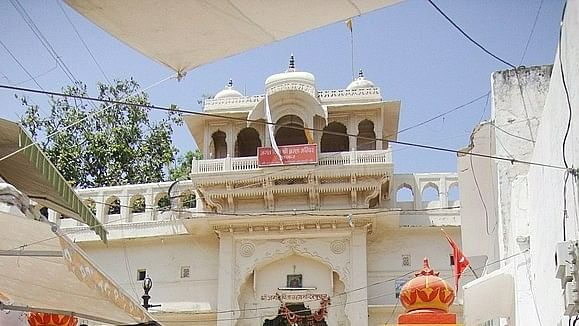
Brahma temple in Pushkar.
Credit: Wikimedia Commons
Jaipur: Purohits in the holy and picturesque temple town of Pushkar, forced the closure of its world famous Brahma temple today in protest, as thousands of fishes are dying everyday and floating up on the surrounding ghats, inconveniencing them and the pilgrims.
Fishes are said to be dying for the past 21 days and floating up on the ghats of the Sarovar. Angry purohits, who have approached the local administration several times, apprising them of the dying fishes, today hit the streets, closing the Brahma temple and markets around for more than five hours. Devotees, who came for darshan, had to return without visiting the temple.
Purohits are saying at least 2000 fishes are dying everyday and floating up the surface of the water and gathering at the ghats. Pushkar is surrounded by 52 bathing ghats. The stench has become unbearable but the administration has not taken any action yet. And as such the purohits are not able to do the puja paths at the ghats. Angry purohits sat on the steps of the temple and did not allow the doors to open.
Pushkar, around 143 km from Jaipur, nestled amidst the Aravalli hills, is one of holiest places in India, where asthi visarjan or ashes immersion take place. According to Hindu religion, the body is immortal and transient, whereas the spirit is everlasting. Asthi visarjan represents the soul’s passage from the corporeal to the spiritual realm. HIndus believe that by pouring the ashes into sacred water bodies, the soul is cleansed and released from the cycle of rebirth.
Pushkar Sarovar sees Hindu families from India and abroad partaking in the ashes immersion rituals here. Pushkar is also one of the few places in India, which has a Brahma temple.
Another important date is the Pushkar fair or Pushkar mela which ends on Kartik Purnima and is held in honour of Lord Brahma. The mela sees a huge congregation of devotees, who believe taking a dip in the sarovar, especially on that day, would cleanse them of their sins and any diseases.
Secretary of Teerth Purohit Sangh, Pushkar, Narayan Adali said they have been informing the administration for the past 15 days and had duly informed the SDM Nikhil Kumar Poddar of the situation as devotees were unable to come and purohits were unable to perform the puja due to the stench, which is hurting the religious sentiments of the devotees.He said the local administration has not been forthcoming on the steps to clean up the lake and restore its sanctity.
Poddar, however, said the fishes are dying to reduced oxygen level in the Sarovar. He added that an oxygen plant is supplying oxygen to the sarovar and that four fountains have been installed and there are plans to install four more fountains. Fresh water is being pumped into the Sarovar from a tubewell, surrounding areas are being cleaned and the dead fishes are being removed. He says the efforts have made the place cleaner by 70 percent. Experts say the addition of a fountain means that water is constantly breaking the surface, thus oxygenating the pond in the process, keeping fishes healthy.
Devesh Mukherjee, a purohit in Pushkar said some poisonous food items may have been thrown in the sarovar, which could also lead to the death of the fishes.
Rachna Singh,a tourist, who had come today to Pushkar, was disappointed as she had to return to Jaipur to catch a flight back and hence did not have the time to wait for the temple to open. “We are very sad but purohits have a point. We are tourists but there are many others who come here for asthi visarjan, how would they do the puja amidst this stench and dying fishes?”
Omkar Singh Lakhawat, senior BJP leader and chairman of Rajasthan Heritage Conservation and Promotion Authority said the scientific reasons behind the death of fishes would be analysed and a permanent solution to this problem would have to be found out as keeping the Sarovar clean and sacred is one of the priorities of this government as it is linked with faith and belief of people.
Around 2009-10, the lake had almost dried up due to depletion of ground water and also due to desilting of the lake by digging it up. The lake was initially fed by both groundwater and surface water. But due to excessive extraction of groundwater, the lake was forced to depend on surface water to survive.